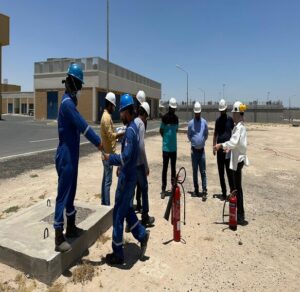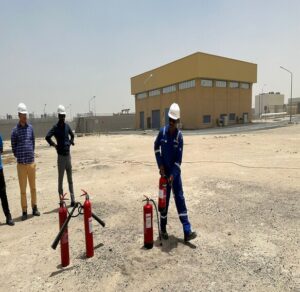BASIC FIRE SAFETY IN KUWAIT
Fire Safety Training in Kuwait | We deliver fire safety training to companies, for support with more complex training needs, or to enquire about on-site training, please get in touch
By the end of the fire safety training you will:
- Best practices for preventing fires
- How to use fire extinguishers, including the PASS technique
- Understanding fire blankets and other firefighting tools
- Developing and practicing evacuation plans
- Workplace-specific fire safety protocols and procedures
What is Fire Safety Training
Fires are the second leading cause of death in the world. The importance of fire safety courses cannot be overstated, as it is one of the most effective ways to reduce fire-related incidents. The National Fire Protection Association (NFPA) estimates that more than 3,000 people die and another 16,000 suffer injuries each year due to fires in the United States alone.
Recently Fire Safety has become a very urgent matter in Kuwait as well with the increase of Fire related accidents it is important that organisations in Kuwait offer their employees a basic training in order to equip them with the necessary surviving skills in order to minimize these emergencies. A fire can happen to anyone and everyone at any time. Basic training on how to handle a fire emergency is one of the most important things you can do for the safety of your employees.
Fire safety training is an important aspect of workplace safety and a crucial component of any company’s health and safety plan. The main purpose of fire safety training is to teach employees how to respond in the event of a fire. It is essential that every employee knows what to do in the event of a fire so that they can act quickly and potentially save lives.
As the world becomes more interconnected, there is an increased risk of fire accidents. Fires can start anywhere, and they can spread quickly. It’s important to take fire safety seriously and make sure that everyone in the organization has a basic understanding of how fires work and what to do when they occur.
Fire safety training should be mandatory for all employees, regardless of their position, as it could be the difference between life and death. The importance of fire safety training cannot be overstated. It is a critical step in any organization’s safety plan. Fire safety training offers numerous benefits to employees, and the best way to ensure they are educated on this crucial topic is by giving them the chance to join our fire safety training in Kuwait at Infinity Training.
Who Should Attend
Fire safety training is crucial for all employees and individuals within an organization to ensure the safety of personnel and protect the workplace from the potential devastation caused by fires.
Fire Safety Training in Kuwait | Benefits of Joining
Improved Emergency Response
Fire safety training equips employees with the knowledge and skills to respond effectively during a fire emergency
Reduced Risk of Injury and Loss of Life
Proper training ensures that employees are aware of potential fire hazards and know how to avoid them
Enhanced Employee Confidence
Training employees in fire safety procedures boosts their confidence in handling emergency situations.
Preservation of Property and Assets
Fire safety training helps prevent or minimize property damage and loss of assets
Cost Savings
Preventing or minimizing fire incidents through training results in cost savings related to property damage, insurance premiums, legal liabilities, and business interruption
Effective Use of Fire-Fighting Equipment
Employees trained in fire safety know how to use fire extinguishers and other fire-fighting equipment correctly. This can help control small fires before they escalate
Content Outline
Introduction to Fire Safety
Importance of fire safety awareness, Statistics on fire-related incidents and their impact
Fire Prevention
Identifying common fire hazards in different settings (home, workplace, public spaces), Best practices for preventing fires, including proper storage and handling of flammable materials
Fire Safety Equipment
Types of fire extinguishers and their appropriate use (e.g., water, foam, CO2, dry chemical), Hands-on training in using fire extinguishers, including the PASS technique, Overview of other firefighting tools (fire blankets, hose reels, fire hoses)
Emergency Evacuation Procedures
Developing and practicing evacuation plans, Understanding the importance of clear escape routes and assembly points, Roles and responsibilities during evacuations
Emergency Alarms and Signals
Understanding different fire alarm systems and their signals, Responding appropriately to fire alarms
Workplace Fire Safety
Workplace-specific fire safety protocols and procedures, Fire safety roles and responsibilities within an organization
Response to Different Fire Types
Understanding appropriate firefighting methods for different types of fires, Practical demonstrations of fire suppression techniques
Review and Assessment
Recap of key concepts and techniques covered, Written or practical assessment to gauge understanding
Emergency Contacts and Reporting
Knowing who to contact in case of a fire emergency, Reporting fire hazards and incidents
GALLERY







